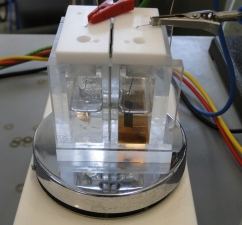Research on new methods of producing 99mTc for nuclear medicine
22-03-2022
In recent years, work has been underway on alternative routes to the production of technetium-99m, used in nuclear medicine. An example is the use of cyclotrons or linear accelerators. One of the stages of obtaining technetium using this method is currently being investigated by scientists from OR POLATOM at NCBJ.
Technet-99m is the most common radioisotope used in nuclear medicine and accounts for approximately 85% of these procedures. In the production of the so-called Molybdenum-technetium generators, research nuclear reactors, such as the MARIA operating at NCBJ, play an extremely important role. Molybdenum-99 is formed in them during the irradiation of plates containing uranium-235. An interesting alternative to the production of technetium-99m seems to be the use of cyclotrons or linear accelerators for this purpose. The target material consists of molybdenum disks, which are dissolved in the subsequent production stages.
„Dissolving irradiated molybdenum is most often carried out by chemical method, through oxidation in a concentrated solution of hydrogen peroxide, and then alkalization with 5 M NaOH” – describes Ph.D. Izabela Cieszykowska from OR POLATOM. „Unfortunately, this reaction is exothermic and violent, with the evolution of oxygen, which means that it must be constantly monitored and carried out with great care.” Scientists from OR POLATOM recently proposed another method – electrochemical dissolution, which, with similar efficiency, can ensure greater safety and the possibility of full automation of the process.
„We performed electrochemical dissolution of molybdenum disks using the galvanostatic method. The possibilities of complete dissolution of molybdenum in the shortest possible time were investigated, depending on the current density, temperature, KOH concentration or addition of hydrogen peroxide to the electrolyte solution” – explains Ph.D. Izabela Cieszykowska. „The results obtained show that this method achieves performance similar to those currently used, but it is easier to control, which is an important aspect when the process is later implemented in industrial production.”
Alternative methods for the production of medical technetium-99m are the object of interest of many groups of scientists and in-depth research is constantly being carried out on them, also at the National Center for Nuclear Research. Our scientists have already dealt with, among others developing a method of obtaining molybdenum discs, which then go to an accelerator for irradiation. More information can be found at: www.ncbj.gov.pl/en/aktualnosci/technetium-and-other-radioactive-isotopes-healthcare
A full description of the current research by OR POLATOM scientists is available in the article:
Cieszykowska, I., Jerzyk, K., Żółtowska, M. et al. Studies on electrochemical dissolution of sintered molybdenum discs as a potential method for targets dissolution in 99mTc production. J Radioanal Nucl Chem 331, 1029–1037 (2022). https://doi.org/10.1007/s10967-021-08155-3





